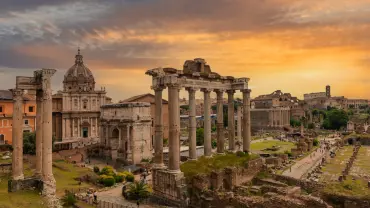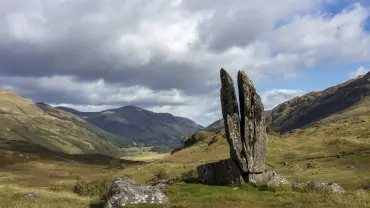The story of Manco Capac, deeply interwoven with myth and folklore, and including elements of divine intervention and miraculous occurrences, has been passed down through generations, encapsulating the mystical aura that surrounds the origins of the Inca Empire.
Known in Quechua, a family of indigenous South American languages, as Manqu Qhapaq, or ‘the royal founder’, the first Inca leader is a legendary figure in Peruvian history and culture. But was he a figure rooted in the rich mythology of the Inca culture, or did he actually exist?
Let’s take a trip back to the twelfth century in an attempt to uncover the myth – or reality – of Manco Capac, the founder of the Inca.
The Early Years of Manco Capac

Manco Capac, founder of the Inca civilisation (Credit: PHAS/Universal Images Group via Getty Images)
It’s believed that Manco Capac – sometimes known as Ayar Manco, Manco Inca and Manqu Qhapaq – was born sometime in the late twelfth century in a town called Tamputoco, which may be in the modern-day Peruvian province of Pumacurco, around 660 kilometres east of the famous Nazca Lines.
His father, in some versions of the story, was called Apu Tambo, and when he died, Manco Capac succeeded him as the head of a nomadic tribe of several dozen families called ayllu. Their travels took them, as the story says, to what is now the city of Cusco, but this is where the narrative becomes a heady mix of alleged fact and apparent fiction, and over the centuries it has become almost impossible to separate the two.
One of the major issues with attempting to unravel this fascinating tale is that the Inca, as sophisticated as they were, lacked a written language. Their history and legends were passed down orally by specially trained people known as ‘quipucamayocs’ or ‘keepers of the quipu.’ These quipus were knotted cords used to record information, but they also played a role in preserving narratives, such as that of the first Inca leader.
How Did Manqu Qhapaq Become the Founder of the Inca?

Inca Emperor Manco-Capac and Queen Coya Mama-Ocllo. (Credit: Florilegius / Contributor via Getty Images)
The Inca Empire, one of the most powerful and sophisticated civilisations in pre-Columbian America, has its origins shrouded in two main legends. These legends, although different in their narratives, both emphasise divine intervention and a sacred mission, reflecting the deeply spiritual nature of the Inca culture.
The Legend of Manco Capac and Mama Ocllo
The most well-known legend is that of Manco Cápac and Mama Ocllo, who were believed to be the children of the sun god Inti and the moon goddess Mama Quilla. According to this legend, they emerged from either the waters of Lake Titicaca or from a cave called Pacaritambo, depending on the version of the story.
Inti sent them to found a great civilisation and gave Manco Inca a golden staff. They were instructed to find the perfect place to establish their empire by thrusting the staff into the ground at a location where it would sink completely. After a journey of perhaps 400 kilometres north, they reached the fertile valley of Cusco, where the staff sank into the earth, indicating the chosen site.
Manco Cápac then established the city of Cusco and, as the first Inca leader, laid the foundation of the Inca Empire. Mama Ocllo taught the women, while Manco Cápac taught the men, setting the societal structures of the empire.
It should be noted that this version of the legend didn’t appear in writing until the early 1600s in the book Comentarios Reales de los Incas, most likely written by Inca Garcilasco de la Vega. However there may have been earlier spoken versions of the story.
The Legend of the Ayar Brothers
The second legend revolves around the Ayar brothers – Ayar Auca, Ayar Cachi and Ayar Uchu, and Ayar Manco – who later became Manqu Qhapaq, and in this story was the son of a pre-Inca creator god named Viracocha.
Along with their four sisters, Mama Ocllo, Mama Huaco, Mama Raua and Mama Ipacura, (in some adaptations of the legend the women were the wives of the Ayar brothers), and other nomadic families, they set out to find a suitable place to establish their kingdom. Again, there are a number of variations of this story but it seems that Ayar Manco somehow got the better of his three brothers, including one being tricked into returning to the cave from which they emerged, and one turning to stone.
Eventually, Ayar Manco, the only brother left, reached the valley of Cusco. He threw a golden rod into the ground, which disappeared, indicating the chosen location for the founding of the Inca Empire. Ayar Manco then took the name Manco Cápac and, like in the first legend, became the founder of the Inca Empire.
Some retellings of this story suggest that Manco Capac and his older sister Mama Ocllo got married and had a son named Sinchi Roca who succeeded his father as the second ruler of the Incan Empire. However while this story is part of the legend, it lacks historical evidence. The lineage of early Inca rulers is not well-documented.
Was Manco Capac Real?

Historic painting of Manco Capac (Credit: Historical Picture Archive / Contributor via Getty Images)
Present-day opinions are divided on whether Manco Capac was a historical figure or a mythical creation. Some suggest he may have been a real leader, transformed over generations into a mythic figure. Others view him purely as a symbolic character, embodying the Inca’s celestial and cultural origins.
Archaeological evidence of Manco Capac himself is sparse, and combined with the lack of written records, this has limited the understanding of the Inca founder to largely speculative interpretations. The few artefacts and ruins attributed to his era provide scant concrete information about his life or rule.
However, despite the scarcity of solid evidence, Manco Capac’s frequent appearance in Inca legends has led many historians to believe that he was more than just a mythical character; he likely had a real presence in history. Nonetheless, the lack of conclusive evidence about his existence leaves open the question of whether he was an actual historical figure or solely a myth.
The House That Manco Capac Built

The ancient Inca ruins of Machu Picchu. (Credit: Kelly Cheng Travel Photography via Getty Images)
By 1572, the Inca Empire was gone, conquered by the Spanish, but in the intervening 270 years or so, they achieved remarkable feats in architecture, agriculture, and governance, leaving a lasting legacy that continues to fire the imagination.
At its height, the empire encompassed much of present-day Peru, western Ecuador, the western and south-central portions of Bolivia, the northwest of Argentina, a small section of southwestern Colombia and much of Chile.
The Inca were master builders, creating extraordinary structures such as Machu Picchu, an architectural marvel set high in the Andes, which remains one of the most significant and well-preserved remnants of their empire.
The Inca also established a vast and efficient road network, stretching as much as 40,000 kilometres, facilitating trade, communication, and military movement across diverse and challenging landscapes. They utilised advanced agricultural techniques, including terracing and irrigation systems, which maximised crop production in challenging mountainous terrains.
Their unique administrative system, which included a complex hierarchy and the use of quipus for record-keeping, allowed them to manage a vast empire that extended across much of western South America. Despite their eventual demise, the achievements of the Incan Empire continue to captivate historians, archaeologists, and visitors from around the globe.
And it all started with Manco Capac.
The Enduring Legacy of the First Inca Leader

The statue of Manco Capac, Plaza de Armas at Cusco, Peru (Credit: al_la via Getty Images)
Manco Capac’s influence reaches far beyond the physical remains of Cusco, which is now a bustling, modern city and a UNESCO World Heritage Site. His story has profoundly shaped the cultural and spiritual practices of Andean communities, and is deeply rooted in the history of the Inca Empire.
Celebrated for his divine lineage and his pivotal role as the inaugural Inca ruler, Manco Capac’s memory is kept alive in contemporary Peru through various festivals and ceremonial practices which pay homage to the Inca heritage.
Indeed Manco Capac occupies a pivotal place in Peruvian history and folklore. Although the specifics of his existence are intertwined with mythological narratives, his fundamental contribution to the founding of the Inca Empire and the establishment of Cusco is deeply rooted.
Manco Capac’s enduring legacy as the founder of the Inca Empire, whether perceived as a historical figure or a legendary icon, stands as a symbol of the extraordinary accomplishments of the Inca civilisation.












